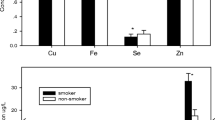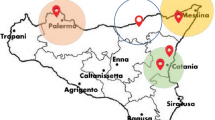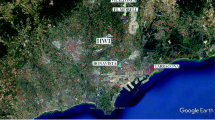Abstract
The white stork (Ciconia ciconia) is being increasingly used in biomonitoring programmes of environmental contaminants due to its growing population in Europe; however, studies on inorganic elements are scarce. The blood of 70 white storks was collected and analysed by inductively coupled plasma mass spectroscopy (ICP-MS) to determine the presence of the following elements: lead (Pb), mercury (Hg), arsenic (As), nickel (Ni), iron (Fe), zinc (Zn), copper (Cu), selenium (Se), manganese (Mn), chromium (Cr), cobalt (Co), and cadmium (Cd). Our main goals were to determine the mean concentrations of these elements in the blood and to study its association with age and gender. Mean concentrations were highest for Fe, followed by Zn, and lowest for Co and Cd. The metal levels were similar to the values referred in the literature for the same species from different locations. No statistically significant differences were found between males and females. Regarding age, statistically significant differences were observed for Ni, Cu, Se, Hg, and Pb between young and adult animals (except for Pb, values in adults were higher than in fledglings). Many element concentrations were correlated, with the strongest correlations between the pairs Hg–Se, Hg–As, and Fe–Zn, mainly in adults. This study provides the baseline data for a monitoring program based on white stork blood as a nondestructive sample.


Similar content being viewed by others
References
Alvarez CR, Moreno MJ, Alonso LL, Gómara B, Bernardo FJG, Martín-Doimeadios RCR et al (2013) Mercury, methylmercury, and selenium in blood of bird species from Doñana national park (Southwestern Spain) after a mining accident. Environ Sci Pollut Res 20(8):5361–5372
Baos R, Bias J, Bortolotti GR, Marchant TA, Hiraldo F (2006a) Adrenocortical response to stress and thyroid hormone status in free-living nestling white storks (Ciconia ciconia) exposed to heavy metal and arsenic contamination. Environ Health Perspect 114(10):1497–1501
Baos R, Jovani R, Pastor N, Tella JL, Jiménez B, Gómez G et al (2006b) Evaluation of genotoxic effects of heavy metals and arsenic in wild nestling white storks (Ciconia ciconia) and black kites (Milvus migrans) from southwestern Spain after a mining accident. Environ Toxicol Chem 25(10):2794–2803
Benito V, Devesa V, Muñoz O, Suñer MA, Montoro R, Baos R et al (1999) Trace elements in blood collected from birds feeding in the area around Doñana National Park affected by the toxic spill from the Aznalcollar mine. Sci Total Environ 242(1–3):309–323
Berglund ÅM, Koivula M, Eeva T (2011) Species-and age-related variation in metal exposure and accumulation of two passerine bird species. Environ Pollut 159(10):2368–2374
Beyer WN, Spann JW, Sileo L, Franson JC (1988) Lead poisoning in six captive avian species. Arch Environ Contam Toxicol 17(1):121–130
Binkowski LJ, Meissner W (2013) Levels of metals in blood samples from mallards (Anas platyrhynchos) from urban areas in Poland. Environ Pollut 178:336–342
Binkowski TJ, Sawicka-Kapusta K (2015) Lead poisoning and its in vivo biomarkers in Mallard and Coot from two hunting activity areas in Poland. Chemosphere 127:101–108
Blanco G, Frias O, Jimenez B, Gomez G (2003) Factors influencing variability and potential uptake routes of heavy metals in black kites exposed to emissions from a solid-waste incinerator. Environ Toxicol Chem 22(11):2711–2718
Blázquez E, Aguirre J, Martínez-Haro M, Mateo R, Jiménez B (2006) The use of white stork (Ciconia ciconia) nestlings in a biomonitoring programme for organochlorines through the region of Madrid (Spain). Organohalogen Compd 68:2081–2084
Burger J, Gochfeld M (1997a) Age differences in metals in the blood of herring (Larus argentatus) and franklin’s (Larus pipixcan) gulls. Arch Environ Contam Toxicol 33(4):436–440
Burger J, Gochfeld M (1997b) Risk, mercury levels, and birds: relating adverse laboratory effects to field biomonitoring. Environ Res 75(2):160–172
Burger J, Gochfeld M (2009) Comparison of arsenic, cadmium, chromium, lead, manganese, mercury and selenium in feathers in bald eagle (Haliaeetus leucocephalus), and comparison with common eider (Somateria mollissima), glaucous-winged gull (Larus glaucescens), pigeon guillemot (Cepphus columba), and tufted puffin (Fratercula cirrhata) from the aleutian chain of Alaska. Environ Monit Assess 152(1–4):357–367
Cabo P, Espín S, Martínez-López E, Roscales JL, Jiménez B, García-Fernández AJ (2012) Metales pesados en sangre de pollos de cigüeña blanca (Ciconia ciconia) de Madrid y Aragón. Revista de Toxicología 29(1):72
Carneiro M, Colaco B, Brandao R, Ferreira C, Santos N, Soeiro V et al (2014) Biomonitoring of heavy metals (Cd, Hg, and Pb) and metalloid (As) with the portuguese common buzzard (Buteo buteo). Environ Monitor Assess 186(11):7011–7021
Carneiro M, Colaço B, Brandão R, Azorín B, Nicolas O, Colaço J et al (2015) Assessment of the exposure to heavy metals in griffon vultures (Gyps fulvus) from the Iberian Peninsula. Ecotox Environ Safe 113:295–301
Clarke JU (1998) Evaluation of censored data methods to allow statistical comparisons among very small samples with below detection limit observations. Environ Sci Technol 32(1):177–183
Cuvin-Aralar MLA, Furness RW (1991) Mercury and selenium interaction: a review. Ecotox Environ Safe 21(3):348–364
Dauwe T, Bervoets L, Blust R, Pinxten R, Eens M (2000) Can excrement and feathers of nestling songbirds be used as biomonitors for heavy metal pollution? Arch Environ Contam Toxicol 39(4):541–546
De la Casa-Resino I, Hernández-Moreno D, Castellano A, Pérez-López M, Soler F (2014) Breeding near a landfill may influence blood metals (Cd, Pb, Hg, Fe, Zn) and metalloids (Se, As) in white stork (Ciconia ciconia) nestlings. Ecotoxicology 23(8):1377–1386
De la Casa-Resino I, Hernández-Moreno D, Castellano A, Pérez-López M, Soler F (2015a) Chlorinated pollutants in blood of white stork nestlings (Ciconia ciconia) in different colonies in Spain. Chemosphere 118:367–372
De la Casa-Resino I, Hernández-Moreno D, Castellano A, Soler Rodríguez F, Pérez-López M (2015b) Biomarkers of oxidative status associated with metal pollution in the blood of the white stork (Ciconia ciconia) in Spain. Toxicol Environ Chem 97(5):588–598
Eeva T, Ahola M, Lehikoinen E (2009) Breeding performance of blue tits (Cyanistes caeruleus) and great tits (Parus major) in a heavy metal polluted area. Environ Pollut 157(11):3126–3131
Eisler R (1986) Chromium hazards to fish, wildlife, and invertebrates: a synoptic review. Fish and Wildlife Service, US Department of the Interior
Eisler R (1993) Zinc hazards to fish, wildlife, and invertebrates: a synoptic review. Biol Rep 10:33–47
Eskildsen J, Grandjean P (1984) Lead exposure from lead pellets: age-related accumulation in mute swans. Toxicol Lett 21(2):225–229
Evers DC, Savoy LJ, DeSorbo CR, Yates DE, Hanson W, Taylor KM et al (2008) Adverse effects from environmental mercury loads on breeding common loons. Ecotoxicology 17(2):69–81
Falandysz J, Jakuczun B, Mizera T (1988) Metals and organochlorines in four female white-tailed eagles. Mar Pollut Bull 19(10):521–526
Florea A, Büsselberg D (2006) Occurrence, use and potential toxic effects of metals and metal compounds. Biometals 19(4):419–427
Fossi C, Leonzio C (1993) Nondestructive biomarkers in vertebrates. CRC Press, Boca Raton
Franson JC (1996) Interpretation of tissue lead residues in birds other than waterfowl. In: Beyer WN, Heinz GH, Redmon-Norwood AW (eds) Environmental contaminants in wildlife. Interpreting tissue concentrations. Lewis Publishers, Boca Raton, pp 265–279
Franson JC, Pain DJ (2011) Lead in birds. In: Beyer WN, Meador JP (eds) Environmental contaminants in biota. Interpreting tissue concentrations. Taylor and Francis Group, Boca Raton, pp 563–593
Furness R (1993) Birds as monitors of pollutants. Birds as monitors of environmental change. Springer, Berlin, pp 86–143
García Fernández AJ, Sánchez-García JA, Jiménez Montalbán P, Luna A (1995) Lead and cadmium in wild birds in southeastern Spain. Environ Toxicol Chem 14(12):2049–2058
García-Fernández A, Sánchez-García J, Gómez-Zapata M, Luna A (1996) Distribution of cadmium in blood and tissues of wild birds. Arch Environ Contam Toxicol 30(2):252–258
Gariboldi JC, Bryan AL, Jagoe CH (2001) Annual and regional variation in mercury concentrations in wood stork nestlings. Environ Toxicol Chem 20(7):1551–1556
Gaunt AS, Oring LW, Council O (1997) Guidelines to the use of wild birds in research. Ornithological Council, Washington
Gómez G, Baos R, Gómara B et al (2004) Influence of a mine tailing accident near Donana National Park (Spain) on heavy metals and arsenic accumulation in 14 species of waterfowl (1998 to 2004). Arch Environ Contam Toxicol 47:521–529
Grand JB, Franson JC, Flint PL, Petersen MR (2002) Concentrations of trace elements in eggs and blood of spectacled and common eiders on the Yukon-Kuskokwim delta, Alaska, USA. Environ Toxicol Chem 21(8):1673–1678
Griffiths R, Daan S, Dijkstra C (1996) Sex identification in birds using two CHD genes. Proc Biol Sci R Soc 263(1374):1251–1256
Hernández LM, Gómara B, Fernández M, Jiménez B, González M, Baos R et al (1999) Accumulation of heavy metals and As in wetland birds in the area around Doñana National park affected by the Aznalcollar toxic spill. Sci Total Environ 242(1):293–308
Hofer C, Gallagher FJ, Holzapfel C (2010) Metal accumulation and performance of nestlings of passerine bird species at an urban brownfield site. Environ Pollut 158(5):1207–1213
Honda K, Min BY, Tatsukawa R (1986) Distribution of heavy metals and their age-related changes in the eastern great white egret, Egretta alba modesta. Korea. Arch Environ Contam Toxicol 15(2):185–197
Honda K, Marcovecchio JE, Kan S, Tatsukawa R, Ogi H (1990) Metal concentrations in pelagic seabirds from the North Pacific Ocean. Arch Environ Contam Toxicol 19(5):704–711
Interior USD. o. t. (1998) Guidelines for interpretation of the biological effects of selected constituents in biota, water, and sediment. Selenium. In: National Irrigation Water Quality Program Information Report No. 3 United States Department of the Interior. GRA and I
Kalisińska E, Salicki W, Mysłek P, Kavetska KM, Jackowski A (2004) Using the mallard to biomonitor heavy metal contamination of wetlands in north-western Poland. Sci Total Environ 320(2):145–161
Kamiński P, Kurhalyuk N, Kasprzak M, Szady-Grad M, Jerzak L (2006) Dynamics of chemical elements in the blood of white stork Ciconia ciconia chicks from polluted environments in W Poland. In: Tryjanowski P, Sparks TH, Jerzak L (eds) The white stork in Poland: Studies in biology, ecology and conservation. Bogucki Wydawnictwo Naukowe, Poznań, pp 201–211
Kamiński P, Kurhalyuk N, Szady-Grad M, Tkachenko H, Kasprzak M, Jerzak L (2008) Chemical elements in the blood of white stork Ciconia ciconia chicks in differential Poland regions. Med Biol Sci 22(4):31–37
Kamiński P, Kurhalyuk N, Jerzak L, Kasprzak M, Tkachenko H, Klawe JJ et al (2009) Ecophysiological determinations of antioxidant enzymes and lipoperoxidation in the blood of white stork Ciconia ciconia from Poland. Environ Res 109(1):29–39
Kamiński P, Grochowska E, Mroczkowski S, Jerzak L, Kasprzak M, Koim-Puchowska B et al (2015) Sex ratio of white stork Ciconia ciconia in different environments of Poland. Environ Sci Pollut R 22(17):13194–13203
Koivula MJ, Eeva T (2010) Metal-related oxidative stress in birds. Environ Pollut 158(7):2359–2370
Lucia M, André J, Gontier K, Diot N, Veiga J, Davail S (2010) Trace element concentrations (mercury, cadmium, copper, zinc, lead, aluminium, nickel, arsenic, and selenium) in some aquatic birds of the southwest Atlantic coast of France. Arch Environ Contam Toxicol 58(3):844–853
Mansouri B, Hoshyari E (2012) Nickel concentration in two bird species from Hara biosphere reserve of southern Iran. Chin Birds 3(1):54–59
Meharg AA, Pain DJ, Ellam RM, Baos R, Olive V, Joyson A et al (2002) Isotopic identification of the sources of lead contamination for white storks (Ciconia ciconia) in a marshland ecosystem (Doñana, SW Spain). Sci Total Environ 300(1):81–86
Merian E (1991) Metals and their compounds in the environment: Occurrence, analysis and biological relevance. VCH Verlagsgesellschaft mbH, Hoboken
Parslow J, Thomas G, Williams T (1982) Heavy metals in the livers of waterfowl from the Ouse Washes, England. Environ Pollut A 29(4):317–327
Peakall D, Burger J (2003) Methodologies for assessing exposure to metals: speciation, bioavailability of metals, and ecological host factors. Ecotox Environ Safe 56(1):110–121
Pérez-López M, De la Casa-Resino I, Hernández-Moreno D, Galeano J, Míguez-Santiyán MP, de Castro-Lorenzo A, Soler F (2016) Concentrations of metals, metalloids, and chlorinated pollutants in blood and plasma of white stork (Ciconia ciconia) nestlings from Spain. Arch Environ Contam Toxicol 71:313–321
Scheuhammer A (1987) The chronic toxicity of aluminium, cadmium, mercury, and lead in birds: a review. Environ Pollut 46(4):263–295
Sebastiano M, Bustamante P, Costantini D, Eulaers I, Malarvannan G, Mendez-Fernandez P et al (2016) High levels of mercury and low levels of persistent organic pollutants in a tropical seabird in French Guiana, the magnificent frigatebird, Fregata magnificens. Environ Pollut 214:384–393
Tkachenko H, Kurhaluk N (2012) Pollution-induced oxidative stress and biochemical parameter alterations in the blood of white stork nestlings Ciconia ciconia from regions with different degrees of contamination in Poland. J Environ Monitor 14(12):3182–3191
Van Eeden P, Schoonbee H (1996) Metal concentrations in liver, kidney, bone and blood of three species of birds from a metal-polluted wetland. Water Sa Pretoria 22:351–358
Weber C, Reid B (1968) Nickel toxicity in growing chicks. J Nutr 95:612–616
Wilson HM, Petersen MR, Troy D (2004) Concentrations of metals and trace elements in blood of spectacled and king eiders in northern Alaska, USA. Environ Tox Chem 23(2):408–414
Yang D, Chen Y, Gunn JM, Belzile N (2008) Selenium and mercury in organisms: Interactions and mechanisms. Environ Rev 16:71–92
Acknowledgements
The authors thank Dr. Jose Luis Rodríguez from the Laboratory of Genetics of the Faculty of Veterinary Medicine of the University of Extremadura (Caceres, Spain), for the assistance in gender determination, and to the staff of the “Los Hornos” Wildlife Recovery Centre (Junta de Extremadura, Caceres, Spain) for the management and sampling of blood. This research was partially supported by the Consejería de Economía e Infraestructuras of the Junta de Extremadura (Ayuda GR15114, Spain) and by FEDER Funds through the Programa Operativo FEDER (2014–2020) of Extremadura.
Author information
Authors and Affiliations
Corresponding author
Electronic Supplementary Material
Below is the link to the electronic supplementary material.
Rights and permissions
About this article
Cite this article
Maia, A.R., Soler-Rodriguez, F. & Pérez-López, M. Concentration of 12 Metals and Metalloids in the Blood of White Stork (Ciconia ciconia): Basal Values and Influence of Age and Gender. Arch Environ Contam Toxicol 73, 522–532 (2017). https://doi.org/10.1007/s00244-017-0431-8
Received:
Accepted:
Published:
Issue Date:
DOI: https://doi.org/10.1007/s00244-017-0431-8




